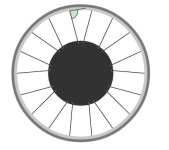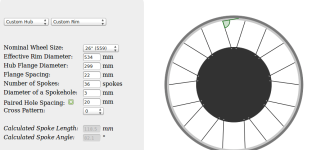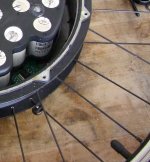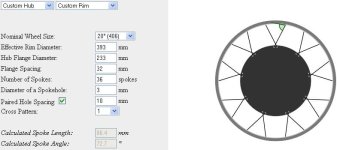We're in the midst of making a better online spoke length calculator tool to address the needs of people lacing up hub motors in to rims, and before going live would like to get a bit of feedback.
The test URL is here:
http://www.ebikes.ca/spokecalculator/index.html
There are a few things missing from most existing tools that I wanted to include
#1) Representative Wheel Drawing This is somewhat self explanatory, but I thought it would be great to have an online app that actually draws the motor, rim, and lacing pattern all dimensionally correct so that you get a visual cue that the numbers and selection are what you want. This also helps you see whether it's feasible to say lace a large diameter hub motor into a 16" rim, or whether double cross pattern really makes sense, or even to idiot check that the ERD number you found for a rim is in the right ballpark.

#2) Paired Spoke Holes An increasing number of hub motors don't have uniform spoke holes around the perimeter but instead group them into pairs. This has a few advantages, it means that straight lacing pattern still has a tangental element to the spokes tension so that you get the torque tranmision benefits of a cross pattern with the lacing simplicity of a radial build. It also allows for a lighter overall motor since large sections of the spoke flange can be cut away. An example is the new Crysatlyte Crown motors for normal spokes:
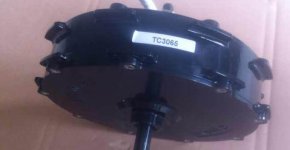
With the new calculator, if you check the box "paired hole spacing", then you can set a custom spacing between adjacent sets of grouped holes rather than have it assume a uniform distribution.
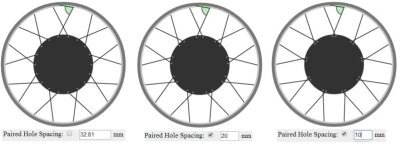
You can also choose with each lacing whether to have initial cross over the adjacent spokes in the pair, or have them initially cross the spoke from the alternate pair:
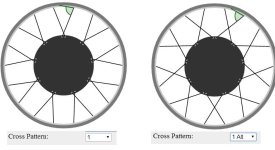
#3) Spoke Angle Measurement Finally, for any of these arrangements it shows the actual angle between the spoke nipple and the tangent where it enters the rim, so that you can quantify the feasibility of a build. I'm not sure what rules of thumb there are for acceptable angles, but my experience is that with eyeletted rims and tight nipples it can often be tricky when this angle is less than about 75-77 degrees, while with rims that don't have eyelets you can usually get away going down to 70, though it's not always pretty.

Anyways, for now I went ahead and measured all of the different hub motors I have kicking around in our lab and filled up the motor drop-down list with that, and similarly with the rims that a lot of our stock wheel builds come in. But I'd be happy to add other specific motor models and rim types which are in common use by ES members here. So if you have a suggestion, AND you have independent measurements of the relative parameters (ERD for the rims, spoke flange diameter and flange spacing for the hubs), then let me know with some justification and we can add it.
The test URL is here:
http://www.ebikes.ca/spokecalculator/index.html
There are a few things missing from most existing tools that I wanted to include
#1) Representative Wheel Drawing This is somewhat self explanatory, but I thought it would be great to have an online app that actually draws the motor, rim, and lacing pattern all dimensionally correct so that you get a visual cue that the numbers and selection are what you want. This also helps you see whether it's feasible to say lace a large diameter hub motor into a 16" rim, or whether double cross pattern really makes sense, or even to idiot check that the ERD number you found for a rim is in the right ballpark.

#2) Paired Spoke Holes An increasing number of hub motors don't have uniform spoke holes around the perimeter but instead group them into pairs. This has a few advantages, it means that straight lacing pattern still has a tangental element to the spokes tension so that you get the torque tranmision benefits of a cross pattern with the lacing simplicity of a radial build. It also allows for a lighter overall motor since large sections of the spoke flange can be cut away. An example is the new Crysatlyte Crown motors for normal spokes:

With the new calculator, if you check the box "paired hole spacing", then you can set a custom spacing between adjacent sets of grouped holes rather than have it assume a uniform distribution.

You can also choose with each lacing whether to have initial cross over the adjacent spokes in the pair, or have them initially cross the spoke from the alternate pair:

#3) Spoke Angle Measurement Finally, for any of these arrangements it shows the actual angle between the spoke nipple and the tangent where it enters the rim, so that you can quantify the feasibility of a build. I'm not sure what rules of thumb there are for acceptable angles, but my experience is that with eyeletted rims and tight nipples it can often be tricky when this angle is less than about 75-77 degrees, while with rims that don't have eyelets you can usually get away going down to 70, though it's not always pretty.

Anyways, for now I went ahead and measured all of the different hub motors I have kicking around in our lab and filled up the motor drop-down list with that, and similarly with the rims that a lot of our stock wheel builds come in. But I'd be happy to add other specific motor models and rim types which are in common use by ES members here. So if you have a suggestion, AND you have independent measurements of the relative parameters (ERD for the rims, spoke flange diameter and flange spacing for the hubs), then let me know with some justification and we can add it.


